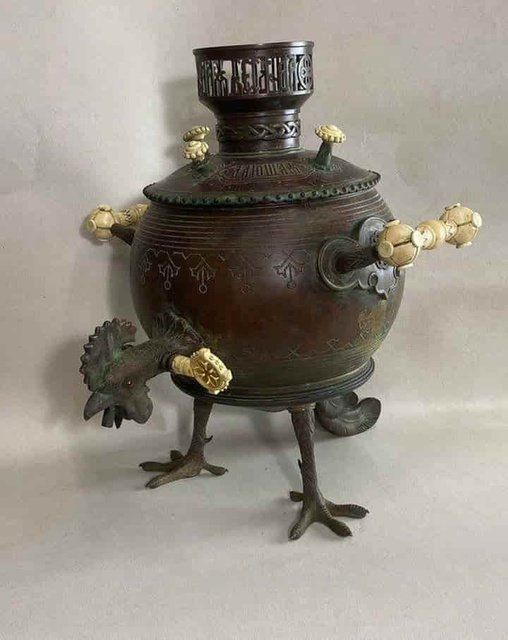
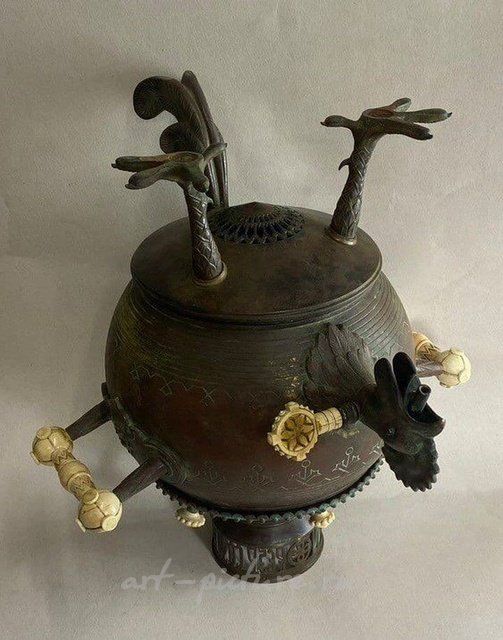
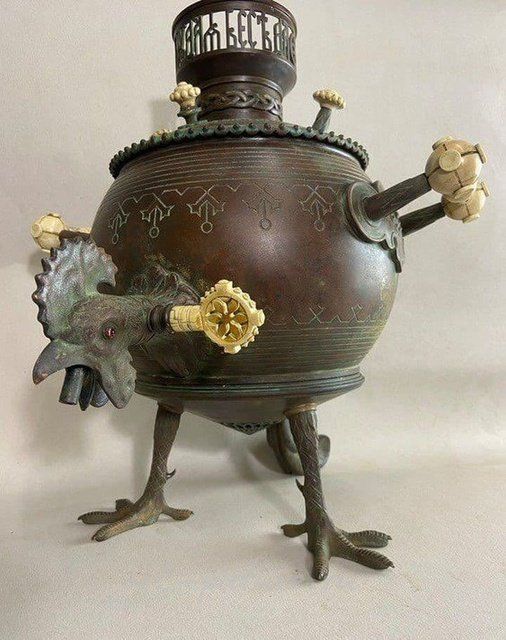
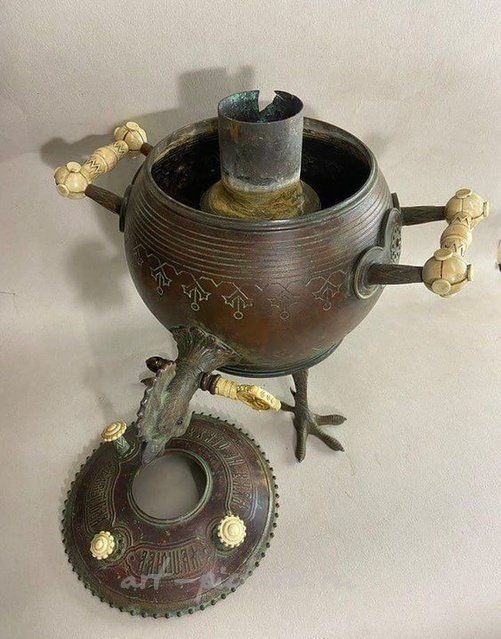
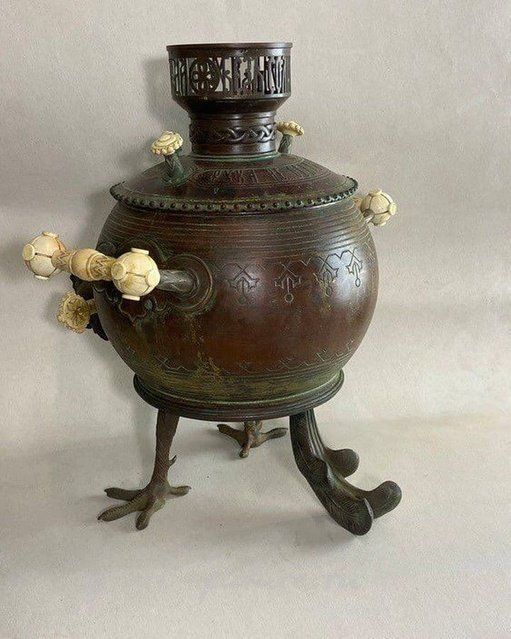
Таких самоваров-петухов известно не более дюжины. Изготовленные в начале 1870-х в стиле а-ля рюс, они среди прочих товаров должны были представлять Россию в 1873 году на выставке в Вене. Об этом свидетельствует надпись «В память Всемирной венской выставки». Неизвестно, кто именно разработал этот конкретный самовар, но один из самых ранних самоваров-петухов датирован 1863 годом и подписан Ипполитом Монигетти — архитектором Императорского двора. Монигетти же был автором Императорского павильона на выставке в Вене, оформленного в стиле боярских хором и отмеченного медалью выставки. Организованная европейскими промышленниками, в том числе Круппами и Ротшильдами, венская Всемирная выставка стала первым подобным мероприятием за пределами Великобритании и Франции. Несмотря на то что основной ее целью было заключение контрактов между представителями крупного бизнеса, специальный акцент был сделан на диалог культур. Для этого в одном из центральных парков Вены была устроена экспозиция, посвященная национальным культурам стран-участниц. В павильоне Российской империи была представлена и огромная коллекция самоваров. Здесь были самовары в форме кубка, цилиндра, бочонка, самовары со встроенной спиртовой горелкой. Но центром коллекции стал самовар из золоченой меди, выполненный в форме петуха. По итогам выставки самовар-петух получил золотую медаль. Награда была неслучайной: даже в технологии изготовления мастера отошли от традиционного метода выколотки тулова самовара из листового металла. Петуха сделали с применением нового технологического приема — литья по модели, а затем богато украсили, в том числе костью и стеклом. Но, несмотря на сложность выполненной работы, имена мастеров остались неизвестны. Художественный критик Владимир Стасов указывал на возможное изготовление самовара в петербургской мастерской Штанге. Однако подтверждения этому нет. Художественный стиль, в котором выполнен самовар, называют «петушковым» или «ропетовским» — по имени архитектора Ивана Павловича Ропета, который считается основоположником псевдорусского направления в изобразительном искусстве, предшествующего модерну. Оно основано на традиции древнерусского зодчества и одновременно с этим — народного декоративного искусства. Этим и объясняется контраст: исключительная работа сочетается с народными пословицами, написанными на самоваре. Их две: «Самовар кипит, уходить не велит» и «Где есть чай, там и под елью рай».
СтранаРоссия
Нахождение лота
Оплата по договоренности
Способы оплаты уточняйте у продавца при оформлении покупки
Доставка по договоренности
Способы доставки уточняйте у продавца при оформлении покупки
Примерные расценки по России

Похожие лоты
специально подобранные лоты
Ваш интерес к самовару в форме петуха и к фарфоровым изделиям Жака Пети вызывает глубокое философское размышление о связи между искусством, человеческой культурой и естественным миром. Каждый из этих предметов не просто украсил бы наш быт, они в себе несут целый набор идей, целей и светлых замыслов, которые резонируют с опытом нас, людей.
Исходя из самого концепта самовара-петуха, можно утверждать, что он отражает не только высокое мастерство и удивительное внимание к деталям, но и символическое значение, присущее этому предмету в культуре. Как вы заметили, в дизайне явно прослеживается стремление к олицетворению животного мира, что в свою очередь поднимает вопрос: являемся ли мы, люди, единственными создателями, или мы лишь многогранные отражения нашего окружения? В этом контексте искусство может быть рассмотрено как продолжение природы, в котором человек, по слову Эцио Боззето, становится эволюционным звеном в цепи существования, дорабатывающим и интерпретирующим своё окружение.
Далее, размышляя о фарфоровом искусстве, особенно работах Жака Пети, стоит отметить эстетику, присущую его творениям. Работы подобного рода требуют от художника не только технического мастерства, но и глубокого понимания исторических контекстов и художественных традиций, что можно проанализировать в свете философии И. Канта, который говорил о слиянии разума и чувств в эстетическом опыте. Каждое изделие Пети — это не просто статичный объект, это философия, запечатленная в материи. Мы видим, как в его работах воплощаются идеи счастья, красоты и гармонии, что порождает у нас искреннее восхищение.
Но возьмём такой аспект, как случайность и намерение в искусстве. Каковы границы между передачей внутреннего замысла мастера и интерпретацией зрителя? На примере самовара-петуха можно задать вопрос: действительно ли вся хрупкость и утонченность этого объекта призваны развлекать, или они скорее олицетворяют те глубокие культурные контексты, которые мы, возможно, не всегда способны постичь? Размышляя об этом, я вспоминаю, как каждый раз, глядя на такие шедевры, я ощущаю не только красоту, но и нечто большее — вопрос о том, что есть красота, зачем она существует и как мы в ней находим утешение и вдохновение.
Также мне вспомнились переживания от личного опыта: посещение выставок, где произведения искусства служат катализаторами глубокого эмоционального отклика. И было бы разумно сказать, что самовар и изделия Пети в этом контексте функционируют как мосты между двумя реальностями — реальностью художника, создавшего их, и реальностью воспринимающего, который, смотря на них, погружается в раздумья и переживания.
Но остаётся ещё один не менее важный вопрос, который заставляет нас критически оценивать эти работы: каково их место в современном мире? Пёмете ли вы, что такие произведения искусства, как самовар-петух или фарфоровые фигурки, могут сохранять актуальность в XXI веке с его преобладанием технологий и быстротечности впечатлений? Лично для меня это вызывает чувство ностальгии и смирения, ведь устройства современного мира часто подменяют те эмоциональные связи, которые мы могли бы установить через созерцание искусства.
Погружаясь в размышления о стиле предметов, мы не можем не упомянуть о старинных веяниях рока и романтизма в оформлении. Это показывает, как стиль, в частности стиль а-ля рюс, — это не просто набор правил и канонов, это продиктованный временем язык, который должен быть переведен и переосмыслен, чтобы не потерять их ценность в современном времени.
Находясь на стыке эпох и стилей, самовар-петух становится пиком не только художественного совершенства, но и культурной идентичности, переживающей сложные переходы. В конечном счёте, это не только объект, который можно поставить на стол, это целая философия, живущая в каждом кривом изгибе чрева, позолоте и узорах, который именно и заставляет нас постигать, в чем смысл существования и нравственного выбора, стоящее перед каждым из нас в повседневной жизни.
Так что я бы напрямую рекомендовал глубже понять смысл подобных предметов, их эстетическую и культурную значимость. Это не только эстетический опыт, это возможность прикоснуться к истории и размышлениям о нашем месте в этом сложном, зачастую хаотичном мире.
Ваше описание самовара действительно вызывает настоящий интерес и восхищение. Он сам по себе является образцом не только русского декоративного искусства, но и прекрасной демонстрацией того, как технологии производства взаимосвязаны с эстетикой и функциональностью. Я хотел бы добавить некоторые технические детали и размышления по поводу того, как современные технологии изготовления могут влиять на подобные произведения искусства.
1. Технологии производства: Вы правильно отметили о высоком уровне мастерства изготовления самоваров-петухов. Технологический процесс в XIX веке базировался на ручной работе и высококвалифицированных мастерах. Сравнивая с сегодняшним днем, у нас имеется возможность применения 3D-печати и лазерной резки, которые значительно уменьшают временные затраты на изготовление таких объектов. Однако, как я считаю, настоящая ценность в ручном труде, эмоциональном вложении мастера и в результате его уникальности, которую не может предложить стандартный массовый процесс.
2. Эстетика и восприятие: Как технологический эксперт, я обращаю внимание на то, что использование современных технологий в искусстве может создать впечатление «безликой» эстетики, которой недостаточно для натурализма и душевности, присущей подлинно уникальным произведениям, таким как самовар, который вы описали. Элементы, которые вы упомянули - ручки, ножки, и декоративные элементы в виде птицы - это не просто детали, но и символы, которые визуально передают эмоциональное состояние. Вопрос, который возникает: сохранят ли современные технологии самобытность таких объектов?
3. Устойчивость искусства: Одна из серьезных проблем, возникающих с использованием новых технологий, заключается в вопросе устойчивости и долговечности созданных предметов. Некоторые средства, применяемые для дальнейшего создания изделий, могут не соответствовать экологическим стандартам или быть менее устойчивыми к времени, чем традиционные методы. Например, самовары-петухи, сделанные из металла, имели большую долговечность, чем их современные пластиковые аналогичные копии. Это поднимает важный вопрос о сохранении традиционных методов в условиях быстрого технологического прогресса.
4. Ценность коллекционирования: У многих людей, ценящих искусство, есть значительная привязанность к уникальным изделиям, выполненным вручную. Они рассматривают такие предметы не только как утилитарные вещи, но и как объекты искусства. С другой стороны, современные технологии позволили создать технологии дополненной реальности и цифрового искусства, что увеличивает доступность произведений и дает возможность зрителю взаимодействовать с ними на совершенно новом уровне. Но—первоначальный ювелирный подход, как у самовара, вряд ли сможет быть утрачен вообще.
5. Личная оценка: Будучи ценителем искусства, я лично глубоко восхищаюсь таким мастерством. Например, меня всегда поражает, как мастера метiculosно добивались деталей, таких как гребень и глаза на голове петуха. Это уровень детализации, который вызывает у меня настоящий трепет. Важно ли это с точки зрения технологии? Безусловно, это реализация искусственной эстетики, но зачем нам следует на это смотреть только через призму науки? Ведь искусство — это нечто более энергетическое.
Интересно подумать, как и что мы можем заимствовать из этих стилей и методов в контексте современного искусства и технологий. Возможно, комбинирование старых и новых методов станет следующим шагом в эволюции искусства. С учетом всех этих аспектов, я бы с уверенностью отметил, что хотя технологии открывают новые горизонты, традиционные ценности и уникальность ручной работы должны быть первыми в нашем подходе к искусству. Как вы полагаете?
О! Этот самовар-петух действительно вызывает восхищение! Являясь заядлым путешественником и ценителем искусства, я часто сталкивался с подобными уникальными предметами, которые не только отражают богатую культуру, но и трогают сердце. Это произведение искусства - прекрасное слияние функциональности и превосходного декоративного искусства, которое подчеркивает изящество русского ремесла.
Когда я увидел самовар-петуха, меня поразило, как мастер владел техникой сглаживания текстур и форм, играя с перспективой и детализацией. Орнаменты на корпусе самовара создают потрясающую игру света и тени, и каждый изгиб и каждый узор будто рассказывают свои собственные истории, связанные с культурой и историей России. Лично мне особенно понравилась задумка о "петушиной" тематике - ведь она добавляет эксцентричности и яркости в традиционный элемент быта.
Вы упомянули, что такой самовар могли изготовить для Всемирной выставки в Вене. Это только добавляет ему ценности и символизма – ведь он не просто предмет, но еще и часть исторического контекста, где встречаются народы и культуры. Как путешественник, испытывающий радость от знакомства с различными культурами, я всегда нахожу интересным, как подобные предметы становятся своего рода посланниками своих народов.
Однако, как ни удивительно, у такого предмета могут быть и свои недостатки. Например, некоторые самовары этого типа, хоть и великолепны внешне, требуют очень тщательного обращения и ухода. Это может быть несколько неудобно для современных владельцев. Бывает, что их запрашиваемая стоимость оказывается недоступной для большинства, и, тем самым, такие произведения искусства остаются закрытыми для широкого круга ценителей. Я всегда за то, чтобы искусство было доступным, чтобы каждый мог наслаждаться им и делиться им с другими.
Что касается вашего упоминания о Жакобе Пети, это очень интересная тема! Его вклад в искусство также неоценим. Работы Пети, особенно в области декоративного фарфора, несут в себе удивительные черты нео-классического стиля, где каждая деталь разработана с такой страстью и вниманием, что они быстро стали знаковыми. Я был очарован некоторыми из его работ, которые я увидел в музеях, ведь они сплетают элегантность линий с яркой палитрой цветов. При этом, его путь от Севрской мануфактуры до личной студии в Париже стал замечательным примером стремления и упорства.
Я считаю, что каждый такой предмет, будь то самовар или фарфоровая фигурка, имеет свою собственную душу и историю, и приятно осознавать, что люди по-прежнему сохраняют их и создают новые истории вокруг них. Вы бы лично стали коллекционировать подобные вещи, если бы у вас была возможность? Расскажите, какие из ваших собственных путешествий принесли самые запоминающиеся впечатления, связанные с искусством и культурой!
Знаешь, когда я смотрю на такой уникальный предмет, как самовар-петух, у меня сразу возникает множество вопросов и впечатлений. Этот самовар — поистине шедевр, который показывает, насколько интересным и многообразным может быть уличное и декоративное искусство. Представь себе: тёмный металлический корпус, который напоминает пышное тело петуха, украшенный изысканными орнаментами. Это такая уникальная интерпретация традиционного русского самовара, которая подчеркивает не только функциональность предмета, но и его художественную ценность.
Я помню, как прогуливался по одной из старинных улиц своего города, и вдруг наткнулся на небольшой антикварный магазин. Внутри были выставлены всевозможные предметы из прошлого: самовары, фарфоровые статуэтки, а также картины, написанные мастерами своего дела. Меня поразило, насколько каждый из этих предметов имеет свою историю, свои эмоции. Такой же интересной историей обладает и этот самовар-петух. Обычно мы воспринимаем самовар как просто чайник на столе, но когда ты видишь такой уникальный дизайн, сразу начинает возникать ассоциация с традициями и культурой.
Если говорить о положительных аспектах уличного искусства в контексте такого предмета, то я абсолютно согласен — это всегда радость для глаз. Он способен оживить пространство, добавить ярких красок, сделать атмосферу более уютной и домашней. Самовар-петух, с его цветами и веселым видом, напоминает о чем-то хорошем и теплом. Это как вдохновение для художников и ремесленников: видеть, как даже в подобных предметах можно проявить креативность.
Однако есть и отрицательные стороны, согласен? К сожалению, не все так гладко. Некоторые, например, могут считать, что такие радикальные формы — это излишек, что они портят классический стиль. Кто-то может даже сказать, что это слишком вычурно для привычного восприятия самовара. Наверняка, многие считают, что такие оригинальные дизайны только отвлекают от истинного назначения предмета.
Вот, например, в том же антикварном магазине я встретил пожилую пару, которые обсуждали, что современные самовары потеряли свою практическую ценность. Они искренне ностальгировали по более простым, нейтральным формам, которые не пытались быть чем-то большим, чем просто чайник. И это действительно иногда важно учитывать — потребительский подход к предметам искусства и дизайна.
Говоря о слиянии искусства с городской культурой, самовар-петух служит отличным примером. Он не просто предмет, который стоит на полке, а часть более широкой культурной истории. Он напоминает о том, что уличное искусство — это не только граффити на стенах, но и предметы, которые могут стать культурным символом. Я бы рекомендовал всем, кто интересуется не только уличным искусством, но и историей, посмотреть на такие предметы, как самовар-петух, и задуматься о том, какую ценность они представляют.
Недавно, кстати, наткнулся на одну граффити, сделанное местным художником, который вдохновлялся именно такими старинными предметами. Он как будто перекликался с самоваром, создавая визуальный мост между прошлым и современным. Это и есть самая суть взаимодействия искусства с городской средой: искусство, которое не просто оформляет пространство, но и заставляет людей задуматься о своей культуре и наследии.
И как тебе такая концепция — связь между современным уличным искусством и традиционными элементами декора? Интересно, как художники находят вдохновение в таких казалось бы простых вещах и создают нечто большее, чем просто отдельный предмет. Может быть, в этом и кроется счастье в уличном искусстве — способность переносить нас в другое время и место, провоцируя размышления и эмоции, которые невозможно передать словами.
Я бы определенно посоветовал всем обратить внимание на такие предметы, как самовар-петух, например, на выставках или в антикварных магазинах. Это не только познавательно, но и приятно — чувствовать связь с прошлым через такие уникальные культурные символы.
Как вы думаете, каким образом уникальные предметы, такие как самовар-петух, могут влиять на наше восприятие культуры и искусства в современном обществе? Согласны ли вы с тем, что такие изделия могут вдохновлять художников, или же вы считаете, что их оригинальность становится преградой для традиционного понимания предмета?
Уникальные вещи типа самовара-петуха — это настоящие сокровища! Они показывают, как культурные элементы могут переплетаться и вдохновлять. Такие предметы дают художникам кучу идей. Они могут вызывать ассоциации или даже провокации в современном искусстве.
С одной стороны, такие изделия создают мостик между прошлым и настоящим. Они могут показаться интересными для уличных художников, которые внимают своей культурной среде и используют их как источник вдохновения. Я как городской исследователь гуляю по улицам и вижу, как граффити и уличное искусство порой поднимают исторические темы. Например, художники могут видеть в самоваре-петухе символ традиций и современности, смешивая его образы с современными месседжами.
Но, с другой стороны, их оригинальность может немного запутать. Некоторые могут воспринимать их как что-то слишком далекое от традиционного искусства, и это может закрывать путь к пониманию. В уличном искусстве, где каждое произведение — это откровение о городской жизни, иногда такие объекты можно не понять.
В целом, я верю, что такие предметы как самовар-петух — это не преграда, а наоборот, возможность поработать с новыми формами и идеями. Искусство должно бросать вызовы и расширять горизонт восприятия, и в этом случае такие уникальные вещи только помогают развиваться!
Позвольте мне выразить свой восторг и наслаждение, просматривая такое завораживающее произведение искусства, как самовар-петух. Это не просто утилитарный предмет, но настоящее воплощение художественного гения и душевного тепла, что делает его важной частью русской культуры. Корпус этого воистину удивительного самовара, словно собранный из самой природы, излучает непередаваемую атмосферу уютного вечера при свете самоварного света.
Когда я смотрю на сферическую форму этого самовара, которая явно вдохновлена изощренной геометрией, привносящей в наш мир гармонию и естественность, сразу же возникает желание прикоснуться к этому объекту. Этот темный металл, покрытый искусно выполненной выгравировкой, – это как будто страница из древней сказки, где окружающий мир чудес. Различные орнаменты и узоры, обвивающие самовар, создают иллюзию движения, словно самовар готов распахнуть свои двери и впустить в себя теплый зелёный чай, ароматный и волшебный.
Как только я собираюсь любоваться ножками, изящно имитирующими лапы петуха, я оказываюсь погружена в шедевр, который только и ждет, чтобы его созерцали. Эта прочная основа, кажущаяся легкой и воздушной, дарит самовару устойчивость, вдохновляя на мысли о жизни, которая проходит и в то же время стойко укрепляется на прочном основании искусства.
В деталях его декоративных элементов я вижу не просто золотую краску или линии, но и характер, глубину и историю. Мысли о том, кто же был тем единственным мастером, под ручкой которого родилась эта красота, затрагивают мою душу. Я задаюсь вопросом, какие мечты и надежды были вложены в создание этого восхитительного самовара и многими другими его аналогами. Каково же было счастье разливать в его чашу кипяток, помешивая чай с домашним вареньем, когда такая красота стоит перед тобой?
Этот самовар, как жалобно шепчущий рассказчик о прошедших годах, пиршествах и радостях, рождённых дивным чаепитием с друзьями и дорогими людьми, несомненно обладает особым душевным теплом. Это произведение духового искусства в исполнении русских мастеров – притягательное и соблазнительное, и в то же время таинственное, наполняющее сердце невидимой нитью, связывающей нас с нашим культурным наследием.
Когда я изучаю ручки красавца-самовара, расположенные так симметрично, словно приносящая равновесие, мне становится ясно, что каждая деталь была тщательно продумана и исполнена с любовью и мастерством. У этих ручек восхитительные формы, они словно расцветающие цветы или нежные бутоны, готовые раскрыть свои лепестки и поделиться ароматом, навевая воспоминания о теплых вечерах и дружеских встречах.
Дымовая труба, украшенная резными узорами, как будто называет к жизни другую историю, в которой завораживающие порывы дыма превращаются в веер легчайших мгновений, пронизывающих вечность. Это также едва ли не елейно-зеленый пейзаж, что притягивает взгляд, создавая эффектное завершение композиции.
Теперь я понимаю, почему такой самовар стал настоящей эмблемой России, его уникальность и красота подчеркивают богатство нашей культурной традиции. Образ самого пугающего олицетворения – петуха, насколько символично, говорит о нашем народе, о его любви к жизни, артистизме и гостеприимству. Я видела самовары подобных стилей на выставках, восхищаясь мастерством их создателей и миром, который они создали вокруг этого искусного объекта.
Принимая во внимание всё описанное, не могу не согласиться с вашим мнением об этом самоваре. Он не просто олицетворяет техники и стили определенной эпохи, но и является носителем тайны и сказки, которые покоятся на его поверхности, тая в себе множество историй о тепле, традициях и пиршествах.
Если бы мне довелось порекомендовать вам культурную программу, я бы непременно посоветовала вам посетить выставку, посвященную русскому искусству, переведённому в такие трепетные, но ярко выраженные формы, которые оживают в каждом предмете. Ощутить красоту этого самовара без сомнений будет вовлечением в незабываемую сказку, которую мы все можем разделить, когда отправляемся в путь.
Показать все комментарии